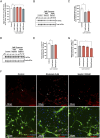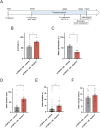Sephin1 reduces TDP-43 cytoplasmic mislocalization and improves motor neuron survival in ALS models
- PMID: 40602832
- PMCID: PMC12225689
- DOI: 10.26508/lsa.202403195
Sephin1 reduces TDP-43 cytoplasmic mislocalization and improves motor neuron survival in ALS models
Abstract
A pathological hallmark of ALS is the abnormal accumulation of misfolded proteins (e.g., TDP-43) and enlarged endoplasmic reticulum (ER), indicating ER stress. To resolve this stress, cells initiate the Unfolded Protein Response (UPR). However, unresolved stress leads to apoptosis. In ALS, UPR activation fails to resolve proteostasis impairment. UPR activation modulators, among them Sephin1, reduce protein aggregates and improve motor neuron survival in ALS models. We demonstrate that following glutamate intoxication, Sephin1 increases motor neuron survival by reducing mitochondria ROS production and extranuclear TDP-43. Sephin1 reduces abnormal splicing because of TDP-43 nuclear loss of function following oxidative stress. In SOD1G93A mice, Sephin1 treatment decreases TDP-43 in triton-insoluble fraction, improving motor neuron survival in spinal cord. Sephin1 improves motor neurons survival, motor function and survival of mutated TDP-43 transgenic zebrafish. Sephin1 improves motor neuron survival in ALS models by reducing TDP-43 cytoplasmic mislocalization and its toxicity. These findings open new therapeutic opportunities for Sephin1 in neurodegenerative pathologies with TDP-43 proteinopathy, including ALS.
© 2025 Abgueguen et al.
Conflict of interest statement
E Abgueguen, BL Lejeune, A Visbecq, and PY Miniou are employed by InFlectis BioScience. PY Miniou is co-founder of InFlectis BioScience. N Callizot is a member of the scientific advisory board and consultant for InFlectis BioScience.
Figures














References
-
- Basso M, Samengo G, Nardo G, Massignan T, D’Alessandro G, Tartari S, Cantoni L, Marino M, Cheroni C, De Biasi S, et al. (2009) Characterization of detergent-insoluble proteins in ALS indicates a causal link between nitrative stress and aggregation in pathogenesis. PLoS One 4: e8130. 10.1371/journal.pone.0008130 - DOI - PMC - PubMed
MeSH terms
Substances
LinkOut - more resources
Full Text Sources
Medical
Molecular Biology Databases
Miscellaneous
